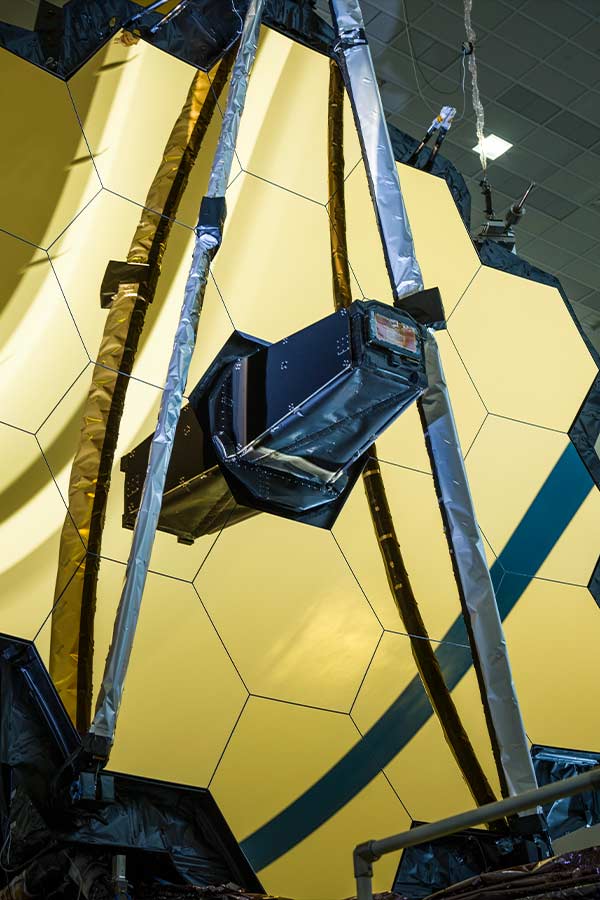Women's History Month Panel with NASA's Webb Space Telescope
Programs
March 16, 2023 5:30pm - 6:30pm
Hear from the galactic experts of NASA's Webb Space Telescope about the science and discoveries of this cutting-edge space observatory.
Event Details
As the largest and most complex observatory ever, NASA’s James Webb Space Telescope launched on December 25, 2021. After going through a six-month period of preparation that included 50 major deployments, careful alignment of the mirrors, and calibrating the instruments, Webb released its first full-color images and spectroscopic data on July 12, 2022. A partnership with ESA (European Space Agency) and the Canadian Space Agency (CSA), Webb is the premier observatory of the next decade, serving thousands of astronomers worldwide. It will study every phase in the history of our Universe, ranging from the first luminous glows after the Big Bang, to the formation of solar systems capable of supporting life on planets like Earth, to the evolution of our own Solar System.
At 4:30 p.m. join Dr. Quyen Hart in the second floor lobby and explore the universe like never before in the fully immersive Webb Virtual Reality (WebbVR) experience. The James Webb Space Telescope and its infrared-light perception of the cosmos are simulated using NASA data, along with bonus information and interactive learning experiences. Fly up close to Webb’s beautiful golden mirrors, and look out from its perspective on the universe. Fly through Saturn’s rings or join Jupiter’s moons in orbit around the gas giant. You may also leave the Solar System behind and visit the stunning Orion Nebula, where a swirling disk of gas and dust is beginning to form planets or fly through the star fields of a simulated galaxy. Explore our newest environment and point the telescope at targets that Webb has recently observed and see the images in this unique VR environment.
At 5:30 p.m. in the Texas Spirit Theater listen in as scientists Amber Straughn, Stefanie Milam, Knicole Colón, and Macarena Garcia Marin have a conversation with Laura Betz, the Webb Communications Team Lead from NASA’s Goddard Space Flight Center. They will talk about Webb’s latest scientific discoveries, how this observatory will continue to explore the uncharted territories of our cosmos and share recent photos that Webb has sent back to Earth. Seating for this event will begin at 5:30 p.m., is first come first served, and is not guaranteed with an RSVP.
These programs are included with the price of Museum admission. Your admission ticket includes exhibition access until 7:00 p.m. and Third Thursday activities.
Dr. Amber Straughn is an Astrophysicist at NASA's Goddard Space Flight Center in Greenbelt, MD and serves as the Deputy Project Scientist for James Webb Space Telescope Science Communications. She is also the Associate Director of the Astrophysics Science Division.
Dr. Stefanie Milam is a Planetary Scientist at NASA's Goddard Space Flight Center in Greenbelt, Maryland and serves as the James Webb Space Telescope Deputy Project Scientist for Planetary Science. Milam is from Houston, Texas, where she first fell in love is Astronomy and NASA through multiple visits to NASA's Johnson Space Center.
Dr. Knicole Colón is an Astrophysicist at NASA’s Goddard Space Flight Center in Greenbelt, MD. She is the James Webb Space Telescope Deputy Project Scientist for Exoplanet Science. Colón also serves as the Project Scientist for the Pandora SmallSat mission and the Director of the Transiting Exoplanet Survey Satellite (TESS) Science Support Center. She previously served as the Deputy Operations Project Scientist for the Hubble Space Telescope.
Dr. Quyen Hart is the Project Scientist for Webb Science Communication in the Office of Public Outreach at the Space Telescope Science Institute in Baltimore, Maryland USA. Dr. Hart earned her Ph.D. from the University of Colorado Boulder, where she studied active super-massive black holes in clusters of galaxies. For more than two decades, Dr. Hart has been actively involved in formal and informal astronomy education, providing unique learning experiences for people of all ages. She is passionate about sharing the wonders of astronomy and science to the general public because she knows that everyone can be a scientist!
Dr. Macarena Garcia Marin is an Astrophysicist and Instrument Scientist for the European Space Agency and Deputy Project Scientist in the Webb Mission Office at the Space Telescope Science Institute. Since 2015, she has worked in operations, calibration, and commissioning of the Mid-infrared Instrument (MIRI) on the James Webb Space Telescope and most recently lead the MIRI team from 2019–2022. Macarena is an expert in mid-infrared imaging and spectroscopy and is part of international collaborations that use space and ground-based observatories to understand the origin and evolutions of our galaxies, from the dawn of the Universe to our own galactic center.
Laura Betz is the NASA Goddard Communications Team Lead for one of NASA's top priorities, the James Webb Space Telescope. She manages science writing and public outreach strategy for the international mission. Prior to NASA, Laura gained experience from her time at National Geographic, Discovery, Maryland's Secretary of State's International Affairs office, WUSA9, and the University of Maryland's Student Legal Aid Office.
Public programs at the Bullock Museum explore relevant history and celebrate the culture that has shaped our modern world. Through engaging discussions, live performances, and experiential activities guests are invited to see local connections and discover how Texas fits into a broader national story.
Your Support Matters
Help us continue to share the story of Texas with a tax-deductible donation.
Enjoy discounts, exclusive programs, and free access to exhibitions year-round by becoming a member of the Bullock Museum.
The Bullock Museum, a division of the Texas State Preservation Board, is funded by Museum members, donors, and patrons, the Texas State History Museum Foundation, and the State of Texas.
Banner image credit NASA, ESA, CSA, and STScI
